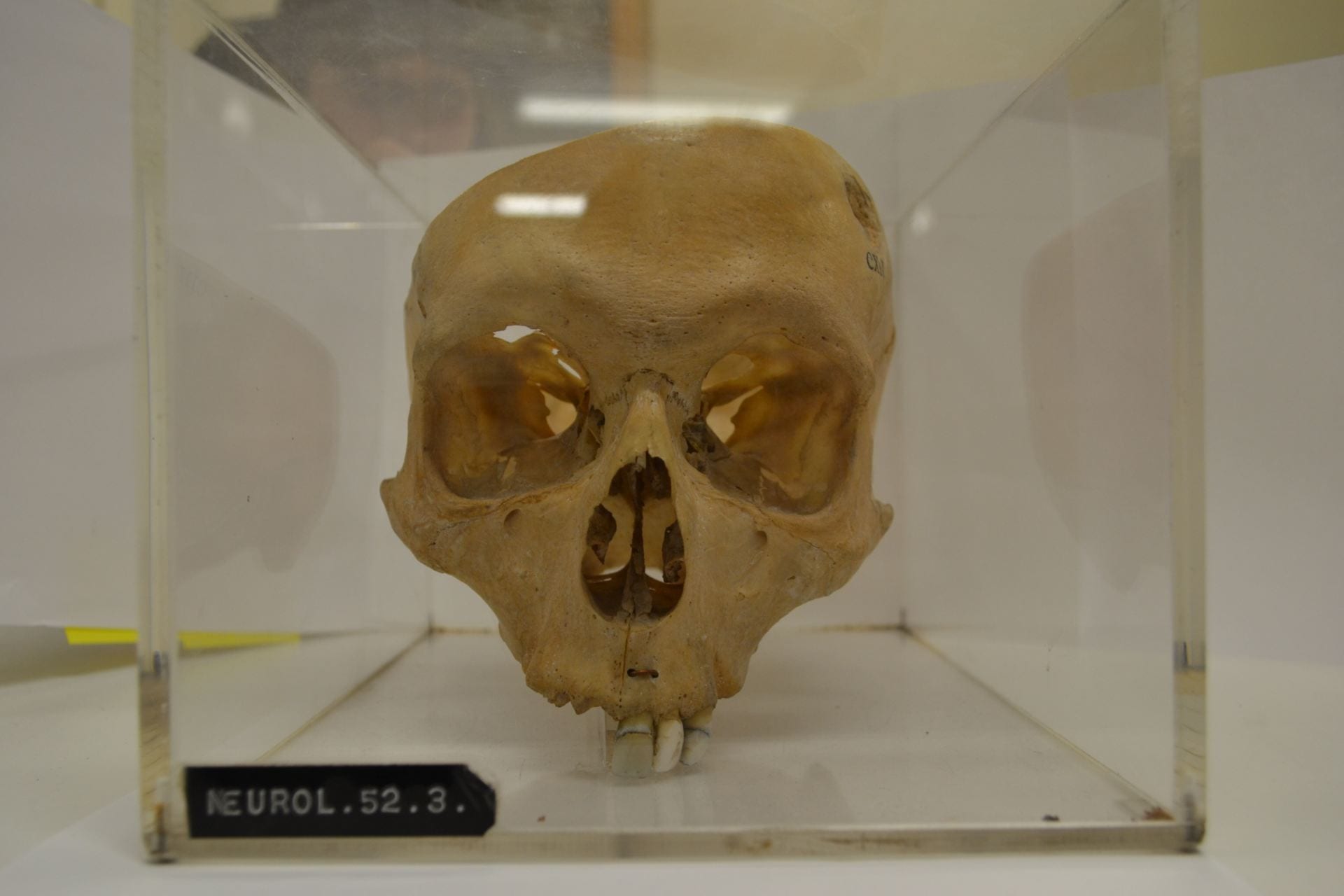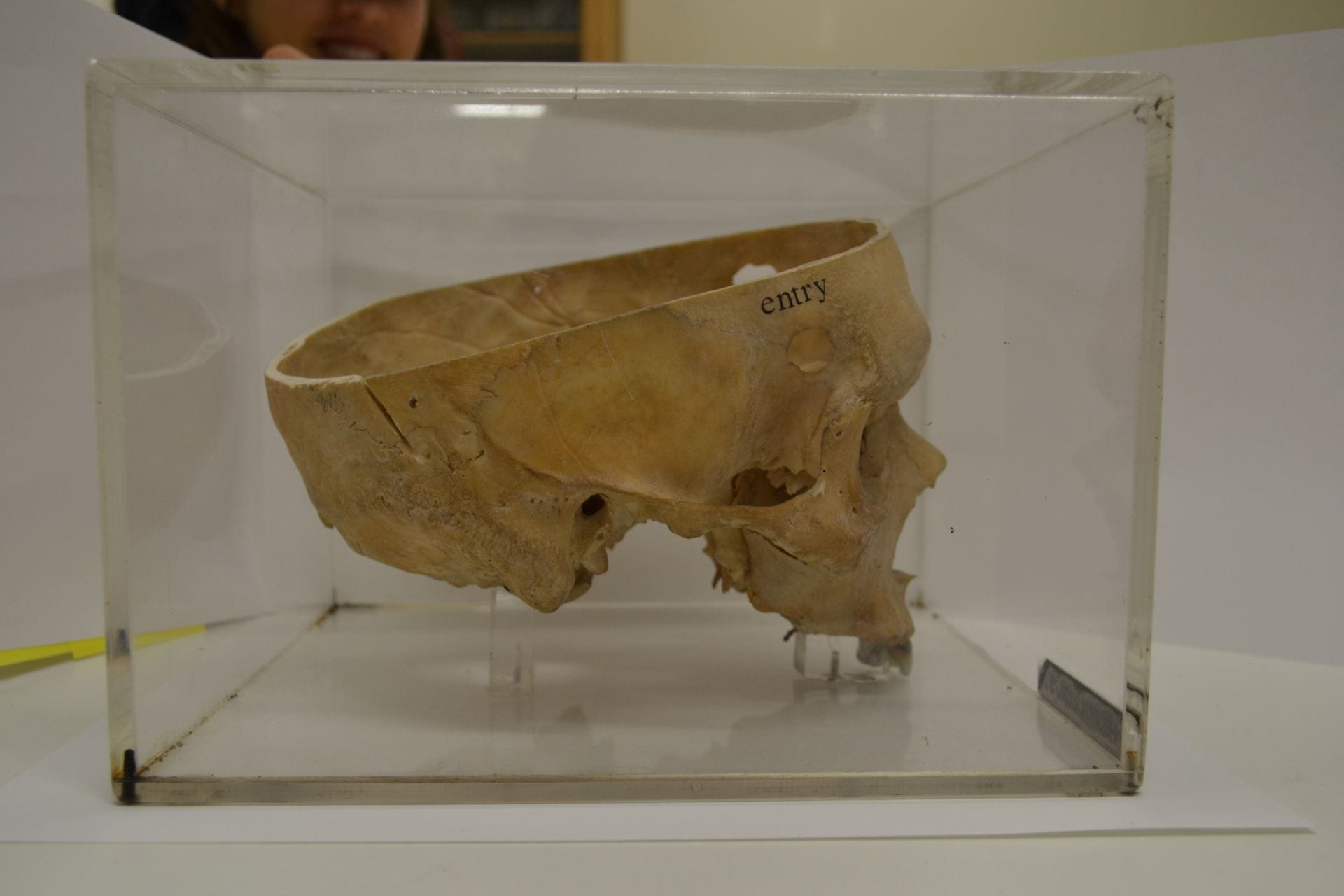[Last modified: March, 25 2019 12:10 AM]

Image courtesy of UCL Pathology museum, taken by Lillian Caccia
About
As a pathology specimen in the ‘death by accident’ collection at the Royal Free Hospital, this object carries with it a multitude of questions concerning the human identity and social life that once belonged to the deceased person. On the surface, the skull is an educational artifact that has allowed scientists to understand the effect of bullets on the human body. However, the mystery of the identity of this person remains unsolved; we do not know for certain the name, gender, age, or even date of death. The profundity of the wider social issues that are raised make it a tragedy that the person who wants lived has not been preserved over time.
|
Object name |
Suicidal Bullet Head Wound |
|
Collection name |
Pathology, Royal Free Hospital |
|
Catalogue number |
Neurol. 52.4 |
|
Material |
Human bone |
|
Dimensions |
7 inches x 9 inches long |
Protection
There are major risk factors that contribute to the likelihood of an individual committing suicide, for example social isolation, mental disorders and chronic disease, however these can vary by age group, culture, sex, and other characteristics. Often stemming from negative changes or social situations that lead to social isolation or hostility, preventative healthcare consequently tends to look at the protective factors that can reduce the risk of suicide. These include connection to individuals, community, family and social institutions, effective behavioural healthcare and self-esteem and sense of purpose in life. Moreover, this object can also be used to emphasise the need for fluidity and progression of cultural values. The root causes of suicide and mental illness are embedded in social values, stigmas and gender roles which ought to be reshaped to prevent such occurrences.

Side. Image courtesy of UCL Pathology museum, taken by Lillian Caccia
Want to know more?
Toxic Masculinity
75% of suicide deaths in the UK are males and it is the most common cause of death among men aged between 20 and 49 years old in England and Wales (Office for National Statistics, 2016), and similar epidemiological findings are evident around the world. One sociological reason for the higher prevalence of suicide among men could be found in studies on masculinity. The term ‘toxic masculinity’ is used to describe the notion that men need to be strong, self-helping, domineering and distant from their emotions, and has been popularised in the last decade in an attempt to call this idea out as harmful. The correlation between men with strong masculinity beliefs and accessing preventative healthcare has been demonstrated in recent studies. Hence it seems the paradigm of toxic masculinity has created a world where men feel it is a weakness and an affront to their masculinity to seek help for anxiety and mental illness.

Toxic masculinity. Illustrator: Mark Long. Found at: https://www.theguardian.com/commentisfree/2019/jan/16/men-masculinity-gillette-advertisement
Further Reading
Monbiot, G., 2019. The fear that lies behind aggressive masculinity. The Guardian. Available at: https://www.theguardian.com/commentisfree/2019/jan/16/men-masculinity-gillette-advertisement
Office for National Statistics (2016). Suicides in GB, 2016 Registrations – ONS. [online] Available at: https://www.ons.gov.uk/peoplepopulationandcommunity/birthsdeathsandmarriages/deaths/bulletins/suicidesintheunitedkingdom/2017registrations
Reiss, N., Dombeck, M., Becoming Suicidal: Sociocultural Contributions. MentalHelp.net. Available at: https://www.mentalhelp.net/articles/becoming-suicidal-sociocultural-contributions/
Springer, K., Mouzon, D., 2011, “Macho men” and preventive health care: implications for older men in different social classes. J Health Soc Behav. Available at: https://www.ncbi.nlm.nih.gov/pubmed/21490311
Recommended Next:
